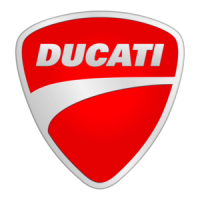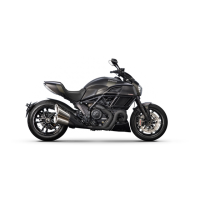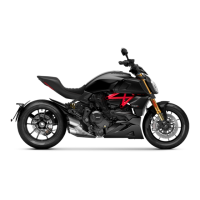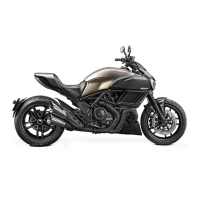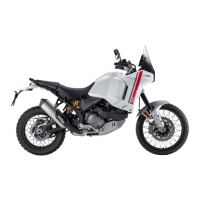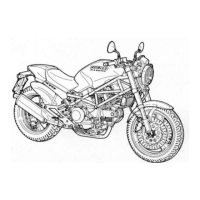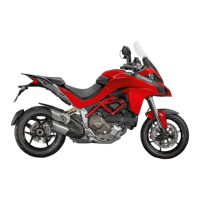Do you have a question about the Ducati Diavel 2014 and is the answer not in the manual?
General advice for safe operation and motorcycle care.
Explains various warning, important, and note symbols used throughout the manual.
Specifies how and where the motorcycle should be ridden, and its limitations.
Outlines legal and safety responsibilities for riders, including licensing and attire.
Emphasizes the importance of rider experience and proper vehicle use for safety.
Details essential protective riding gear for rider and passenger safety.
Provides critical operations for rider safety and motorcycle performance.
Explains the importance of the frame number for identification and ordering spare parts.
Explains the importance of the engine number for identification and ordering spare parts.
Overview of the handlebar-mounted LCD instrument panel and its indicators.
Explains the function and behavior of the ABS indicator light under different conditions.
Describes the color TFT display on the tank fairing and its functions.
Declares vehicle compliance with radio equipment directive and lists manufacturers' addresses.
Identifies and describes the purpose of buttons on the instrument panel for menu navigation.
Explains how to set and display various parameters on the instrument panel.
Details the primary functions shown on the handlebar LCD, including speedometer, rev counter, clock, and temperature.
Explains how vehicle speed is displayed in Km/h or mph.
Describes how engine revolutions per minute are displayed on the instrument panel.
Details the time indication format and behavior on the instrument panel.
Explains the engine coolant temperature indicator and its display readings.
Lists the available functions within Menu 1 and Menu 2 of the instrument panel.
Explains the total distance travelled display, its permanent saving, and limits.
Describes the partial distance travelled display and its reset function.
Details the second partial distance display and its reset functionality.
Estimates the distance that can be covered based on fuel level and consumption.
Explains how average fuel consumption is calculated and displayed.
Describes the display of real-time fuel consumption.
Details the calculation and display of average vehicle speed.
Explains the display of the duration of a trip.
Describes the display of the outside air temperature and potential influences.
Explains how the engaged gear or neutral is indicated on the panel.
Introduces the available riding modes (SPORT, TOURING, URBAN) and their display background colors.
Step-by-step guide on how to change the motorcycle's riding mode.
Explains the LAP time function's activation and display conditions.
Details the steps for recording lap times using the flash button and memory limits.
Describes how to view recorded lap times, speeds, and RPMs.
Procedure for erasing all stored lap data from the instrument panel memory.
Describes how fuel quantity is indicated using icons and its dependency on MENU 2.
Explains the indication for the side stand being open or in an undefined state.
Details automatic adjustment of display background color based on ambient light.
Sets handlebar instrument panel backlighting intensity (MAX, MIDDLE, MIN).
Alerts the rider about upcoming maintenance or oil changes.
Describes the warning for the first oil service interval.
Explains messages for upcoming OIL or DESMO SERVICE and distance remaining.
Details warnings for OIL or DESMO SERVICE requirements based on distance thresholds.
Alerts for malfunctions not affecting safe operation, displayed on the instrument panel.
Indicates low battery voltage and recommends charging.
Alerts when the DTC system is disabled, advising caution while riding.
Warns when the Hands Free system cannot detect an active key nearby.
Alerts when the battery in the Hands Free key is low.
Indicates high engine coolant temperature and recommends stopping the engine.
Warns when the steering lock cannot be removed, suggesting a procedure.
Alerts for vehicle abnormal behavior or errors detected by control units.
Explains how to access and navigate the setting menu for customizing functions.
Allows customization of individual riding modes' parameters like DTC and Engine settings.
Guide to adjust DTC intervention levels or disable it for each riding mode.
Advice on choosing the correct DTC level based on conditions, riding style, and tyre setup.
Allows customization of engine power and delivery settings for each riding mode.
Procedure to restore factory default parameters for all riding modes.
Function to disable or re-enable Menu 2 display on the main screen.
Adjusts the tank instrument panel background lighting (DAY, NIGHT, AUTO).
Displays RPM in number format for improved idle RPM setting accuracy.
Allows enabling or disabling the LAP time recording function.
Describes the display of battery voltage and its interpretation.
Recommends using a specific battery maintainer for long-term storage.
Instructions for adjusting the time displayed on the instrument panel.
Allows changing units for speed, temperature, and fuel consumption displays.
Allows disabling and enabling the ABS system via the setting menu.
Explains the anti-theft electronic block system and its operation.
Describes the active and passive keys and their functions, including opening compartments.
Step-by-step guide for replacing the battery in the active key fob.
Procedure for obtaining and programming spare keys through an authorized service center.
Explains how to temporarily start the motorcycle if the Hands Free system malfunctions.
Guides on activating and setting a 4-digit PIN code for system access.
Instructions on how to change the existing 4-digit PIN code.
Manages headlight operation, including low beam, high beam, and flashing.
Explains the automatic reset function for turn signals based on distance traveled.
Activates front and rear parking lights for visibility when parked.
Indicates the need to keep a button pressed to engage the steering lock.
Informs the rider that the steering lock has been activated.
Warns about the starter button's incorrect position and potential battery discharge.
Allows enabling and adjusting heated handgrips, if installed.
Shows the location and function of various controls used for riding.
Lists the components of the Hands Free system, including lock, antenna, and keys.
Lists situations that can impair the wireless control operation of the Hands Free system.
Explains how to turn the Hands Free system and electronic devices on and off.
Details using the button on the Hands Free lock for system activation/deactivation.
Explains using the PIN code to activate the system when keys are not detected.
Detailed steps for entering the PIN code to temporarily start the motorcycle.
Describes the dip switch, turn indicator switch, and button functions on the left handlebar.
Explains the function, adjustment, and proper use of the clutch lever.
Details the Red ON/OFF switch and Black ENGINE START button.
Explains the operation of the throttle twistgrip for controlling engine speed.
Describes how to operate and adjust the front brake lever.
Explains how to operate the rear brake pedal.
Details the operation of the gear change pedal for shifting gears.
Guides on adjusting the position of the gear and rear brake pedals for rider comfort.
Identifies the location of key components on the motorcycle.
Instructions for opening and closing the fuel tank cap.
Details how to remove the seat to access the underseat compartment.
Explains how to use the helmet cable for securing a helmet when parked.
Instructions for using the side stand safely and its maintenance.
Describes how to deploy and retract the passenger grab handle.
Explains how to adjust rebound, compression, and spring preload on the front forks.
Details how to adjust damping and spring preload on the rear shock absorber.
Guidelines for the initial break-in period, including speed and braking.
A comprehensive checklist of essential checks before riding the motorcycle.
Explains the ABS light's behavior during operation and malfunction.
Instructions to check the cleanliness of ABS phonic wheels and warnings about wheelies.
Explains how ABS works, its benefits, and rider perception during operation.
Details the steps for starting and stopping the engine using the controls.
Step-by-step guide on how to start moving the motorcycle from a standstill.
Guidance on effective braking techniques, including downshifting and clutch use.
Procedures for safely bringing the motorcycle to a complete stop and turning off the engine.
Instructions for parking the motorcycle, including engaging the steering lock.
Lists the items included in the motorcycle's tool kit.
Advises having air filter maintenance performed by a dealer due to complexity.
Instructions for checking and topping up the engine coolant level.
Guidelines for checking and maintaining brake and clutch fluid levels.
How to check brake pad wear and when replacement is necessary.
Maintenance procedure for lubricating control cables and side stand joints.
How to adjust the throttle grip free play for optimal response.
Instructions for removing the motorcycle cowling to access the battery for charging.
How to check and adjust the drive chain tension for proper operation.
Proper cleaning and lubrication procedures for the O-ring drive chain.
Instructions for replacing headlight bulbs, noting the LED unit.
Procedure for checking and adjusting headlight aim for proper visibility.
Manual adjustment of the rear-view mirrors for optimal viewing.
Recommended tyre pressures for front and rear, rider and passenger.
Specifies the minimum legal tread depth for tyres.
Step-by-step guide to checking and topping up engine oil using the sight glass.
Importance of spark plugs for engine running and recommendation for dealer service.
General advice and precautions for washing and cleaning the motorcycle.
Procedures for long-term storage, including cleaning, fuel, oil, and battery handling.
Mentions country-specific regulations for emissions and noise standards.
Lists maintenance tasks to be performed by authorized dealers based on mileage/time.
Lists basic maintenance tasks that can be performed by the owner.
Provides the dry weight and maximum load capacity of the motorcycle.
Displays the overall physical dimensions of the motorcycle with key measurements.
Lists recommended fuels, oils, and other fluids for the motorcycle.
Provides technical details of the engine, including bore, stroke, displacement, and power.
Explains the Desmodromic timing system with its components.
Details maximum speed, spark plugs, fuel system, and brake specifications.
Lists basic electric items, including headlights, turn indicators, and battery specifications.
Locates fuse boxes and provides a key to identify fuse functions and ratings.
A list of numbered components and their corresponding identifiers in the wiring diagram.
A logbook section to record scheduled maintenance services performed.
General advice for safe operation and motorcycle care.
Explains various warning, important, and note symbols used throughout the manual.
Specifies how and where the motorcycle should be ridden, and its limitations.
Outlines legal and safety responsibilities for riders, including licensing and attire.
Emphasizes the importance of rider experience and proper vehicle use for safety.
Details essential protective riding gear for rider and passenger safety.
Provides critical operations for rider safety and motorcycle performance.
Explains the importance of the frame number for identification and ordering spare parts.
Explains the importance of the engine number for identification and ordering spare parts.
Overview of the handlebar-mounted LCD instrument panel and its indicators.
Explains the function and behavior of the ABS indicator light under different conditions.
Describes the color TFT display on the tank fairing and its functions.
Declares vehicle compliance with radio equipment directive and lists manufacturers' addresses.
Identifies and describes the purpose of buttons on the instrument panel for menu navigation.
Explains how to set and display various parameters on the instrument panel.
Details the primary functions shown on the handlebar LCD, including speedometer, rev counter, clock, and temperature.
Explains how vehicle speed is displayed in Km/h or mph.
Describes how engine revolutions per minute are displayed on the instrument panel.
Details the time indication format and behavior on the instrument panel.
Explains the engine coolant temperature indicator and its display readings.
Lists the available functions within Menu 1 and Menu 2 of the instrument panel.
Explains the total distance travelled display, its permanent saving, and limits.
Describes the partial distance travelled display and its reset function.
Details the second partial distance display and its reset functionality.
Estimates the distance that can be covered based on fuel level and consumption.
Explains how average fuel consumption is calculated and displayed.
Describes the display of real-time fuel consumption.
Details the calculation and display of average vehicle speed.
Explains the display of the duration of a trip.
Describes the display of the outside air temperature and potential influences.
Explains how the engaged gear or neutral is indicated on the panel.
Introduces the available riding modes (SPORT, TOURING, URBAN) and their display background colors.
Step-by-step guide on how to change the motorcycle's riding mode.
Explains the LAP time function's activation and display conditions.
Details the steps for recording lap times using the flash button and memory limits.
Describes how to view recorded lap times, speeds, and RPMs.
Procedure for erasing all stored lap data from the instrument panel memory.
Describes how fuel quantity is indicated using icons and its dependency on MENU 2.
Explains the indication for the side stand being open or in an undefined state.
Details automatic adjustment of display background color based on ambient light.
Sets handlebar instrument panel backlighting intensity (MAX, MIDDLE, MIN).
Alerts the rider about upcoming maintenance or oil changes.
Describes the warning for the first oil service interval.
Explains messages for upcoming OIL or DESMO SERVICE and distance remaining.
Details warnings for OIL or DESMO SERVICE requirements based on distance thresholds.
Alerts for malfunctions not affecting safe operation, displayed on the instrument panel.
Indicates low battery voltage and recommends charging.
Alerts when the DTC system is disabled, advising caution while riding.
Warns when the Hands Free system cannot detect an active key nearby.
Alerts when the battery in the Hands Free key is low.
Indicates high engine coolant temperature and recommends stopping the engine.
Warns when the steering lock cannot be removed, suggesting a procedure.
Alerts for vehicle abnormal behavior or errors detected by control units.
Explains how to access and navigate the setting menu for customizing functions.
Allows customization of individual riding modes' parameters like DTC and Engine settings.
Guide to adjust DTC intervention levels or disable it for each riding mode.
Advice on choosing the correct DTC level based on conditions, riding style, and tyre setup.
Allows customization of engine power and delivery settings for each riding mode.
Procedure to restore factory default parameters for all riding modes.
Function to disable or re-enable Menu 2 display on the main screen.
Adjusts the tank instrument panel background lighting (DAY, NIGHT, AUTO).
Displays RPM in number format for improved idle RPM setting accuracy.
Allows enabling or disabling the LAP time recording function.
Describes the display of battery voltage and its interpretation.
Recommends using a specific battery maintainer for long-term storage.
Instructions for adjusting the time displayed on the instrument panel.
Allows changing units for speed, temperature, and fuel consumption displays.
Allows disabling and enabling the ABS system via the setting menu.
Explains the anti-theft electronic block system and its operation.
Describes the active and passive keys and their functions, including opening compartments.
Step-by-step guide for replacing the battery in the active key fob.
Procedure for obtaining and programming spare keys through an authorized service center.
Explains how to temporarily start the motorcycle if the Hands Free system malfunctions.
Guides on activating and setting a 4-digit PIN code for system access.
Instructions on how to change the existing 4-digit PIN code.
Manages headlight operation, including low beam, high beam, and flashing.
Explains the automatic reset function for turn signals based on distance traveled.
Activates front and rear parking lights for visibility when parked.
Indicates the need to keep a button pressed to engage the steering lock.
Informs the rider that the steering lock has been activated.
Warns about the starter button's incorrect position and potential battery discharge.
Allows enabling and adjusting heated handgrips, if installed.
Shows the location and function of various controls used for riding.
Lists the components of the Hands Free system, including lock, antenna, and keys.
Lists situations that can impair the wireless control operation of the Hands Free system.
Explains how to turn the Hands Free system and electronic devices on and off.
Details using the button on the Hands Free lock for system activation/deactivation.
Explains using the PIN code to activate the system when keys are not detected.
Detailed steps for entering the PIN code to temporarily start the motorcycle.
Describes the dip switch, turn indicator switch, and button functions on the left handlebar.
Explains the function, adjustment, and proper use of the clutch lever.
Details the Red ON/OFF switch and Black ENGINE START button.
Explains the operation of the throttle twistgrip for controlling engine speed.
Describes how to operate and adjust the front brake lever.
Explains how to operate the rear brake pedal.
Details the operation of the gear change pedal for shifting gears.
Guides on adjusting the position of the gear and rear brake pedals for rider comfort.
Identifies the location of key components on the motorcycle.
Instructions for opening and closing the fuel tank cap.
Details how to remove the seat to access the underseat compartment.
Explains how to use the helmet cable for securing a helmet when parked.
Instructions for using the side stand safely and its maintenance.
Describes how to deploy and retract the passenger grab handle.
Explains how to adjust rebound, compression, and spring preload on the front forks.
Details how to adjust damping and spring preload on the rear shock absorber.
Guidelines for the initial break-in period, including speed and braking.
A comprehensive checklist of essential checks before riding the motorcycle.
Explains the ABS light's behavior during operation and malfunction.
Instructions to check the cleanliness of ABS phonic wheels and warnings about wheelies.
Explains how ABS works, its benefits, and rider perception during operation.
Details the steps for starting and stopping the engine using the controls.
Step-by-step guide on how to start moving the motorcycle from a standstill.
Guidance on effective braking techniques, including downshifting and clutch use.
Procedures for safely bringing the motorcycle to a complete stop and turning off the engine.
Instructions for parking the motorcycle, including engaging the steering lock.
Lists the items included in the motorcycle's tool kit.
Advises having air filter maintenance performed by a dealer due to complexity.
Instructions for checking and topping up the engine coolant level.
Guidelines for checking and maintaining brake and clutch fluid levels.
How to check brake pad wear and when replacement is necessary.
Maintenance procedure for lubricating control cables and side stand joints.
How to adjust the throttle grip free play for optimal response.
Instructions for removing the motorcycle cowling to access the battery for charging.
How to check and adjust the drive chain tension for proper operation.
Proper cleaning and lubrication procedures for the O-ring drive chain.
Instructions for replacing headlight bulbs, noting the LED unit.
Procedure for checking and adjusting headlight aim for proper visibility.
Manual adjustment of the rear-view mirrors for optimal viewing.
Recommended tyre pressures for front and rear, rider and passenger.
Specifies the minimum legal tread depth for tyres.
Step-by-step guide to checking and topping up engine oil using the sight glass.
Importance of spark plugs for engine running and recommendation for dealer service.
General advice and precautions for washing and cleaning the motorcycle.
Procedures for long-term storage, including cleaning, fuel, oil, and battery handling.
Mentions country-specific regulations for emissions and noise standards.
Lists maintenance tasks to be performed by authorized dealers based on mileage/time.
Lists basic maintenance tasks that can be performed by the owner.
Provides the dry weight and maximum load capacity of the motorcycle.
Displays the overall physical dimensions of the motorcycle with key measurements.
Lists recommended fuels, oils, and other fluids for the motorcycle.
Provides technical details of the engine, including bore, stroke, displacement, and power.
Explains the Desmodromic timing system with its components.
Details maximum speed, spark plugs, fuel system, and brake specifications.
Lists basic electric items, including headlights, turn indicators, and battery specifications.
Locates fuse boxes and provides a key to identify fuse functions and ratings.
A list of numbered components and their corresponding identifiers in the wiring diagram.
A logbook section to record scheduled maintenance services performed.
| Displacement | 1198.4 cc |
|---|---|
| Power | 162 hp (119 kW) @ 9, 250 rpm |
| Transmission | 6-speed |
| Frame | Tubular steel Trellis frame |
| Front Tire | 120/70 ZR17 |
| Rear Tire | 240/45 ZR17 |
| Seat Height | 770 mm (30.3 in) |
| Fuel Capacity | 17 L (4.5 US gal) |
| Engine Type | L-Twin cylinder, 4 valves per cylinder, Desmodromic |
| Torque | 94 lb-ft (127 Nm) @ 8000 rpm |
| Fuel Injection | Electronic fuel injection, Mikuni throttle bodies |
| Front Suspension | Marzocchi 50mm fully adjustable usd fork |
| Rear Suspension | Sachs monoshock, fully adjustable |
| Front Brake | 2 x 320 mm semi-floating discs, radially mounted Brembo Monobloc 4-piston calipers, ABS |
| Rear Brake | 265 mm disc, 2-piston caliper, ABS |
| Wheelbase | 1, 590 mm (62.6 in) |
| Dry Weight | 210 kg (463 lbs) |
